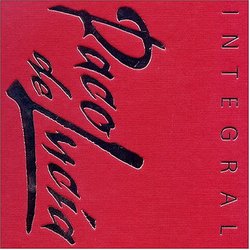Paco de Lucia: the greatest flamenco guitarist
Ian K. Hughes | San Mateo, CA | 06/22/2004
(5 out of 5 stars)
"Paco de Lucía, it can be reasonably asserted, is the greatest guitarist ( "tocaor" ) in flamenco's history. This 26 CD set, containing his complete solo recordings (as of 1998) provides, in tandem with his work as accompanist to legendary singer Camarón de La Isla, as complete an overview as one could ask for in assessing Paco's colossal contribution to flamenco music. The following are brief comments on the most notable albums contained in this set: "FUENTE Y CAUDAL" (1973) shows the 25 year-old Paco as a completely formed musician, already acknowledged within flamenco culture as its premier guitarist (a position he has yet to relinquish). This album is most renowned for the opening "Entre Dos Aguas", a "rumba" that propelled Paco from (mere) renown to certifiable fame. The intense and expressive character of this piece was a unique inspiration that influenced countless numbers of flamenco musicians. For the first time on record, Paco played in an ensemble (including electric bass and congas) that was, at that time, unusual in flamenco music. The title track, a mournful free-form "taranta", is one of Paco's most profound creations, never failing to send chills up the spine. "Cepa Andaluza" is another standout, an explosive piece in the "bulería" style which Paco himself has described as the most complex and characteristic flamenco form. Accompanied "por fiesta" by "palmas" and "jaleos" (hand-claps & shouts of encouragement), this cut practically jumps out of the speaker."ALMORAIMA" (1976) was a landmark event in flamenco music, paying unprecedented attention (for flamenco) to production values while displaying a number of other unique characteristics, not the least of which regarding instrumentation. Electric bass and congas are used on portions of almost all the compositions while a mixed choir is deployed on others. Apart from arrangements, the compositions themselves are much more sophisticated than any Paco had written up to that time, exhibiting remarkable advances in form and invention. Some of Paco's greatest tunes are featured, many of which he plays on tours to this day. "Rio Ancho" is a propulsive, bossa nova style "rumba" with a beautifully expressive melody. The title track, a pulsating "bulerías", is notably Moorish in melodic contour, accentuated by Paco's use of a nylon string "oud" (Arabic lute). The magisterial "Llanos del Real", in the plangent "minera" form, provides a haunting conclusion."INTERPRETA DE FALLA" (1978) has beautiful renditions of Spanish composer Manuel de Falla's pieces (mostly excerpts from his famous ballets). In Paco's hands these pieces are given earthy yet delicate treatments, emphasizing the strong influence which flamenco music had on Falla. "SOLO QUIERO CAMINAR" (1981) was recorded fresh on the heels of Paco's world tour with the famous "guitar trio" (Paco, John McLaughlin & Al Di Meola). Several tunes feature his newly formed group (Paco de Lucía Sextet), an ensemble (guitars, vocals, flute/sax, electric bass, percussion) overwhelmingly influential in the new flamenco blossoming throughout Spain in the 1980's. The title track is a "tangos" with the moving melismatic singing of Paco's brother, Pepe de Lucia. "Palenque" opens up some improvisatory interplay (nice sax solo by Jorge Pardo) while the ingenious "Monasterio de Sal" is duet between Paco and bassist Carlos Benevant. "Chanela" has Paco playing lightning fast "picado" lines and complex Brazilian chords to the grooving congas of Rubem Dantas. The passionate "Piñonate" is "flamenco puro", Paco's "tocando por bulerías" at an all-out level of fiesta intensity."SIROCO" (1987) is another pioneering effort, equal parts tradition and innovation, borne both of Paco's intensely deep reflection and knowledge of "flamenco puro" plus his experiences with jazz musicians such as Chick Corea and John McLaughlin. The mastery displayed on this album is simply staggering- in terms of technical virtuosity ("La Barrosa"), harmonic innovation ( "Callejón del Muro" ) and emotional expression ("Gloria al Niño Ricardo") or rather, all of these elements combined, this recording remains without question the Everest of flamenco guitar playing. "ZYRAB" (1990), much less ambitious than its lofty predecessor, was pieced together in somewhat haphazard fashion. Nonetheless, it contains quite a bit of good music. "Tio Sabas" is Paco's moving tribute ("por tarantas") to the legendary maestro Sabicas while "Soniquete" is yet another incredible "bulerías", bristling with new ideas. "Compadres" is a tightly woven duet with Paco's great contemporary, Manolo Sanlúcar, and the title track (a "fusion" piece with Arabic overtones) features Chick Corea on piano. "Playa del Carmen" is an infectious "rumba" performed by the Sextet. There is even a romantic popular piece (synthesized string accompaniment) entitled "Canción de Amor"."CONCIERTO DE ARANJUEZ" (1991) is Paco's marvelous rendition of Joaquin Rodrigo's famous guitar concerto. The elderly composer, present at the performance, was lavish in his praise (small wonder, considering Paco's sensitive and powerful rendering of the achingly beautiful "adagio")."LUZIA" (1998), is certainly the most intimate (and quite possibly best) recording of Paco's career. Dedicated to his late mother, the album contains strong, inventive and often broodingly introspective material, particularly in the slower pieces ( "La Villa Vieja" and "Luzía" ). As a counterweight, there is light and warmth in the Andean melodies of "Manteca colorá " and Duquende's passionate vocals in "Me regalé ". The two "bulerías" are yet further examples of Paco's creativity and command within that most characteristic flamenco form. The album finishes on a pensive note with "Camarón", a stunningly beautiful free-form "rondeña" dedicated to Paco's late friend. CONCLUSION:Paco de Lucía, a musician of genius, possesses an abundance of what in flamenco is known as "duende": the ability to summon up seemingly inexpressible profundity and communicate it to others. There are quite a few moments of Paco's "duende" heard on this box set, which is unreservedly recommended to flamenco aficionados and all lovers of great music."

